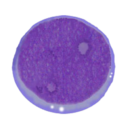The flow cytometric diagnosis of AML: Difference between revisions
From haematologyetc.co.uk
No edit summary |
No edit summary |
||
| Line 9: | Line 9: | ||
'''1.''' '''AML blasts will generally show flow cytometric features consistent with their primitive nature'''</br> | '''1.''' '''AML blasts will generally show flow cytometric features consistent with their primitive nature'''</br> | ||
[[Image:AML M1.png|130px]] | [[Image:AML M1.png|130px]] The typical "primitive" morphology of blast cells is generally accompanied by signs of primitive immunophenotype | ||
*Most often in AML the immunophenotype with have typical features of immature cells. In particular, expect ''weak expression of [[CD45]]'', and expression of ''[[CD34]]'' and/or ''[[CD117]]''. Other markers may be useful in difficult cases (see [[Markers used to demonstrate primitive nature in AML|Click for more detailed description]]) | *Most often in AML the immunophenotype with have typical features of immature cells. In particular, expect ''weak expression of [[CD45]]'', and expression of ''[[CD34]]'' and/or ''[[CD117]]''. Other markers may be useful in difficult cases (see [[Markers used to demonstrate primitive nature in AML|Click for more detailed description]]) | ||
Revision as of 17:28, 17 December 2023
For most cases, the diagnosis of AML by flow cytometry is relatively straightforward. The problem lies in atypical cases and unusual diagnoses that may be missed.
1. AML blasts will generally show flow cytometric features consistent with their primitive nature
 The typical "primitive" morphology of blast cells is generally accompanied by signs of primitive immunophenotype
The typical "primitive" morphology of blast cells is generally accompanied by signs of primitive immunophenotype
- Most often in AML the immunophenotype with have typical features of immature cells. In particular, expect weak expression of CD45, and expression of CD34 and/or CD117. Other markers may be useful in difficult cases (see Click for more detailed description)
- Note that cases where more differentiation has occurred the primitive nature of the AML blats may be less clear. This may cause confusion and is most frequently encountered in monocytic cases of AML or in APL (Click for a more detailed description)
Can we confirm myeloid nature?
- Typical cases can generally be recognised by (see table for details)
- Atypical cases can still be identified based on a minimal feature set (see table for details)
- In unusual cases an extended marker panel may allow lineage assignment (see Table for details)
Are there atypical features?
- Expected abberency
- Feature that may give concern